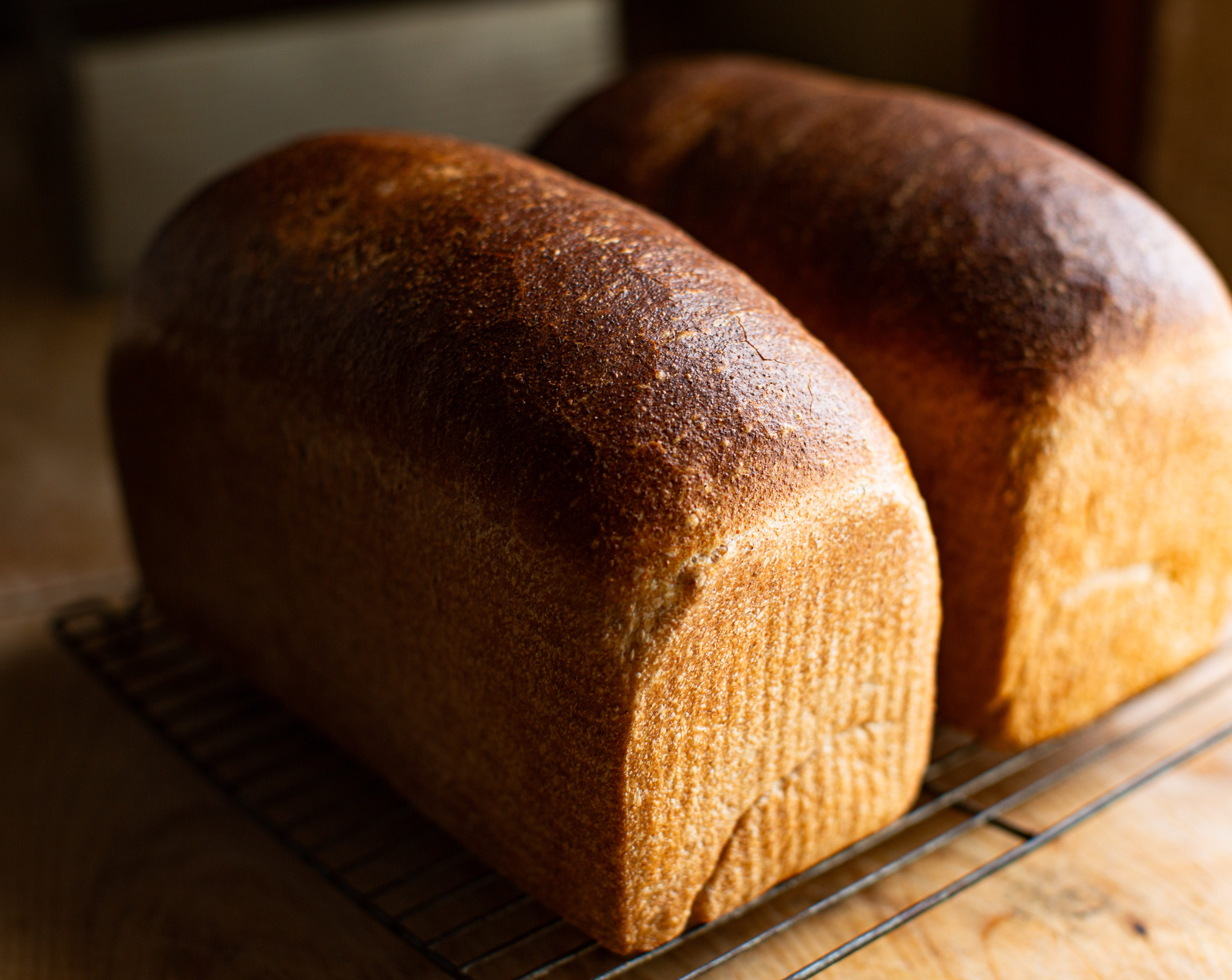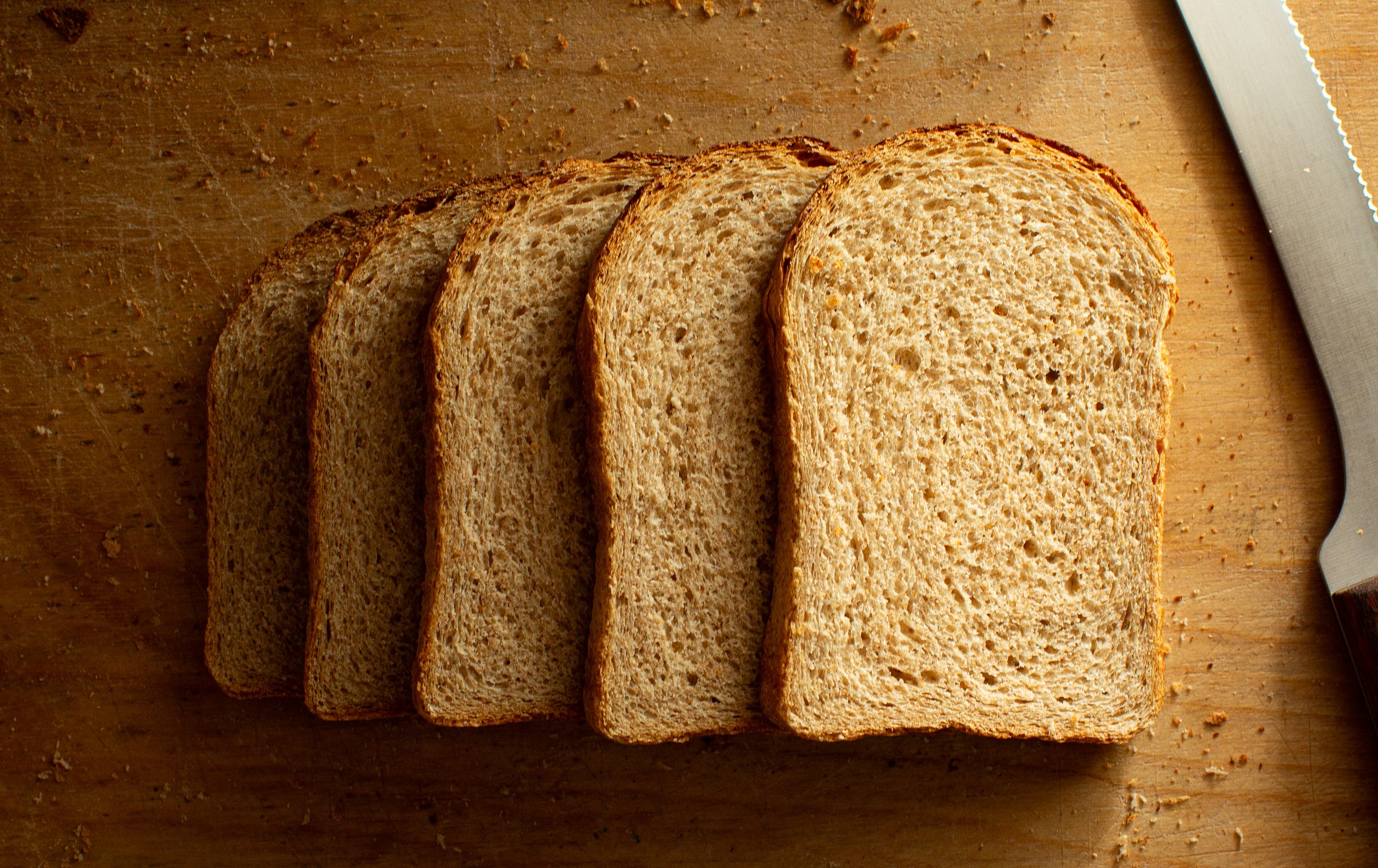Mama's Bread
A slice of home
Something pretty straightforward here, it’s the Mama’s Bread from my book. If the pastries I have in testing now work out, I’ll be back soon with something fun just in time for Mother’s Day. In the meantime, enjoy this whole wheat (and all-purpose) loaf from my childhood.
Happy Spring, Martin
I grew up in a house built on bread. Saturdays, rain or shine, one of my parents clocked in as the baker and mixed our family’s foundation for the week: thirteen loaves, two pounds each. The bran-flecked pile of dough rose directly on the counter (and sometimes over the edge) for a variable portion of the day. Once baked — warm from the oven, top crust polished with a stick of butter — it was devoured. Inhaled. Eaten as part of a weekly ritual that became something akin to communion.
While the schedule was reliable, the bread changed from week to week. My dad was consistent with his high-rising loaves, but my mother made bread like she did scrap quilts: A piece of this, a bit of that, or a leftover bowl of oatmeal, all into the mix — no two batches were the same. And the routine continues, fifty years later. On a recent visit home to see my parents my mother was toasting the last pieces of a batch she made that contained leftover potato salad. Why not?
The bread roots I grew up with took hold in my own life when our kids were little. Looking for something, I found what I needed in a mixing bowl. It was a place where I could connect my heart to my hands and my soul to my mouth.
Clementine — my oldest, and a toddler at the time — would pull up her stool to help. I’d tie a kitchen towel around her waist and watch toddler fingers hand-mix sourdough with warm water, splashing the mixture, squeezing, and laughing. “You want to make bread?” was all I had to say and she’d silently push a stool to the counter. It could be alleged that our kids were raised on buttered toast with jam. But I know better. We also fed them French toast, bread pudding, grilled cheese sandwiches, and salad with croutons.
My wife says that food is my love language, and it’s true that meals make the best words. We say “I love you,” on plates. We say “get up,” with the smell of pancakes. We say “I’m sorry for your loss,” with pie, or fresh rolls. We stack and maintain the foundations and memories of home, one loaf at a time. Here’s one of mine. Thanks, Mama.
Mama’s Bread
Yield: Two large pan loaves
Mix:
All-purpose flour, 516g (4 ¼ cups)
Whole wheat flour, 516g (4 ¼ cups)
Salt, fine, 21g (1 T plus ¾ t)
Yeast, instant, 6g (2 t)
Water*, 659g (3 cups)
Butter, unsalted, melted or very soft, 57g (4 T)
Honey, 26g (1 T plus ¾ t)
*For the water temperature, in cool months with flour temperatures in the 60s, warm your water to 85 to 95°F or so. In warmer months, 75 to 80°F should be good.
In a large mixing bowl, whisk together the flours, salt, and yeast. Add the water, butter, and honey. Mix with your hand or the handle end of a wooden spoon until the dough forms a shaggy, floury mass. Dump the dough out of the bowl and knead until smooth and cohesive, about 2 to 3 minutes. Resist the urge to add more flour.
*Note that this is a relatively firm dough. If you feel like adding a little water and softening it some, drizzle in a few large spoonfuls as you mix. And, if you feel like adding soaked grains, applying a seed crust, stirring in leftover oatmeal, or even potato salad or sourdough culture, that’s ok, too. Mama would approve of all the changes.
The dough will rise in a lidded or covered container for 2 to 3 hours at room temperature. Fold as directed below.


Fold after 30 and 60 minutes. The first fold can be firm — you may even dump onto an unfloured surface (the dough is firm enough that you don’t need flour to keep it from sticking) and knead briefly, about 30 seconds or so. After the brief kneading, the dough should be very smooth. Return it to the covered bowl or container, seam-side-down, to rise for 30 minutes before the second fold.
The second fold is a standard bowl fold: Working your way around the dough, perform 8 to 12 folds, stretching and pressing the outside of the mass into the center. After the bowl fold, invert the mass so that the smooth portion is on top. Cover for the remainder of bulk fermentation.
After the second fold the dough will rise untouched for an additional 1 to 2 hours, until doubled or even tripled in size. (To accurately note the level of rise, use a 6 qt container and mark the dough height before rising.)
To divide, dump the dough onto a lightly floured surface and cut into two pieces weighing about 900g each.
Shape the dough as pan loaves and place in greased 9” by 4” (my favorite, the short pullman), or 9” by 5” bread pans. (Note that this dough makes very good rolls or cinnamon buns if you only want a single loaf. Or, just bake both and give one away in the true style of my mother.)
Cover and proof until the dough is 1 to 1 ½” above the top of the pan, about 90 to 120 minutes, depending on your ambient conditions.
Toward the end of the proof, preheat the oven to 400°F. (For the bakers that have a steaming system set up in their ovens (such as a cast iron pan or similar), these loaves do even better with a little steam. It’s not necessary but the top crust does look nice when it’s slightly shiny.)
Bake on the middle rack until the top and sides are firm and the loaves are a deep golden brown, about 40 to 45 minutes, rotating after 30 minutes.
Remove the loaves immediately from the pans and place on a wire rack to cool. If desired, rub the top crust with butter.







"We say “I love you,” on plates. We say “get up,” with the smell of pancakes. We say “I’m sorry for your loss,” with pie, or fresh rolls. We stack and maintain the foundations and memories of home, one loaf at a time." WOOF Martin, got me right in the heart strings.
I'm looking forward to trying this one! With just two of us in the house I've done like your mother, bake both and give one away. Your Cinamon Oatmeal bake has made me quite popular due to this, thank you!
Goodness, goose bumps after reading that last paragraph. It’s a joy to read your posts and I never know whether to prepare myself to laugh or cry or both. But it’s always good either way. I don’t have these kinds of thoughtful, food related childhood memories but it’s become the way of things in my home with my family and friends and it’s a true blessing. I hope my kiddos recall it all as fondly as you do one day!